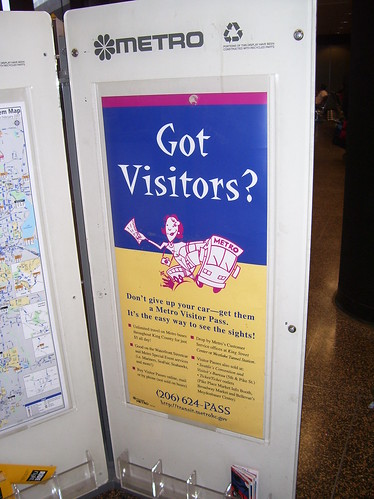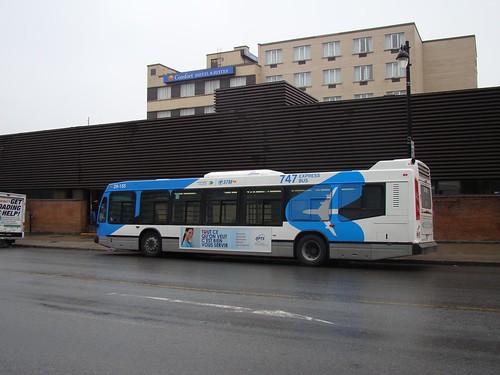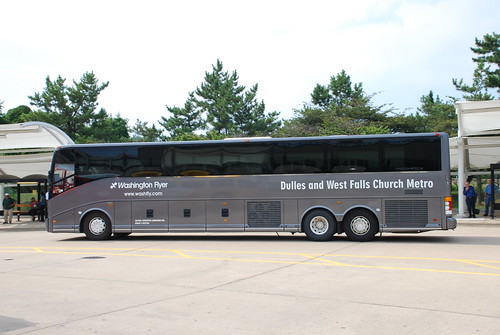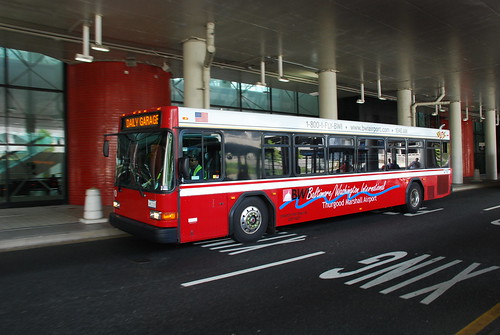More on transportation to the DC area airports...
 Left: there is a four-sided transit information display at the Seattle-Tacoma Airport for service to King County. (You know, now that I think about it, info for getting to Peirce County was kind of weak.) I assume that this has been augmented since the launch of light rail service. Two sides have transit schedules, one side is a transit map of the region, and another side is a promotion ad.
Left: there is a four-sided transit information display at the Seattle-Tacoma Airport for service to King County. (You know, now that I think about it, info for getting to Peirce County was kind of weak.) I assume that this has been augmented since the launch of light rail service. Two sides have transit schedules, one side is a transit map of the region, and another side is a promotion ad.GGW has a piece on a proposal to cut bus service to Dulles Airport from DC ("DC, Fairfax consider cutting the 5A bus to Dulles").
I think if the entry had referenced points in my recent pieces on the subject ("Night moves: the need for more night time (and weekend) transit service, especially when the subway is closed" and "More on airport-related transit/transit for visitors") it might have been more authoritative.
The post is based on a report produced by the WMATA Riders Advisory Council on airport transportation.
The RAC report is weak because it doesn't appear to have referenced research on transit service to airports and didn't consider best practices present at other airports.
Had it done so, the report would have been much more authoritative. For example, the Puget Sound Regional Council produced the Regional Airport Ground Access Plan, and the report is a model for regional transportation planning.
... There is not a comparable report produced for the DC region, although this would be complicated because National and Dulles Airports are in the Washington MPO area, while the BWI Airport is in the Baltimore MPO area. Although this could be an interesting opportunity for the two respective transportation planning units to work together on one report. (Maryland already uses the commuter support system of the MWCOG in the Baltimore area, and the MTA CharmCard is just a differently branded version of the WMATA SmarTrip card. The Maryland State Highway Office partly funds the traffic safety ad campaign in the DC area and also uses the materials elsewhere in the state.)
I'm critical because this ends up being a significantly lost opportunity to try to push the various planning agencies to step up and take some responsibility for airport access and transportation planning as an appropriate "regional" transportation issue.
Some airport planning resources relevant to transportation planning
- Airport Ground Access Planning Guide, Federal Highway Administration Intermodal Division
- Ground Access to Major Airports by Public Transportation, Airport Cooperative Research Program, Transportation Research Board
- Airport Service Quality Best Practice Report, Ground Transportation
- Bulletin 1: Best Practices - Surface Access to Airports, Federal Aviation Administration (this document specifically mentions how airports need to integrate ground transportation planning with the MPO
- A New Procedure for Scoring Rail Transit Connections to U.S. Airports, masters thesis, Mark William Peterson, Virginia Polytechnic Institute
- Why some airport-rail links get built and others do not: the role of institutions, equity and financing, masters thesis, Julia Nickel, MIT
- Air Transportation Planning, Puget Sound Regional Council
- "Ground Access Strategies: Lessons from United Kingdom Airports," Dr Ian Humphreys and Dr Stephen Ison, Transport Studies Group,Department of Civil and Building Engineering, Loughborough University, UK
- Airport Bus and Train website
- Airport Improvement Magazine
- Airport Cities Conference
And the chapter on transit wayfinding from the book
Wayfinding: Designing and Implementing Graphic Navigational Systems is relevant to airports as well.
From the FAA Bulletin:
Airport officials should:
• Regularly participate in MPO technical meetings related to transportation and land use
• Regularly meet with local State DOT field offices and State DOT aviation offices to discuss planned surface transportation activities
• Educate the community on the importance of the airport (establish stakeholder coordination process)
• Obtain local support for airport access (and airfield) projects
• Ensure that airport master plan and state/regional aviation system plans identify surface access needs
• Understand and participate in the development of the region’s long range transportation plan, TIP and the STIP
• Know what justification and data needed to support an off-airport access project
• Work with the State DOT, MPO and transit operator to get worthwhile off-airport access projects on the TIP or long-range transportation plan
• Work with the State DOT and transit operator to get projects on STIP implemented
Note that transit information best practices/visitor information centers at airports is probably a topic that the Airport Cooperative Research Program should take up again.
Recommendations
The report ends up being constrained by the purview of the RAC (WMATA issues specifically, not "transportation" issues more generally) and what looks to be the lack of a solid evaluation framework and approach.
Their primary recommendation is accurate, but bland:
In general, the working group recommends that WMATA, MWAA, MDOT, and other regional stakeholders come together to consider transportation to the region’s airports as a unique yet essential part of their mandate – one that has not been adequately addressed solely through existing mechanisms of cooperation. Concrete progress on this issue will only happen if the entire experience of transportation to the region’s airports is considered. Piecemeal changes,while they may be welcome as solutions micro-level issues, will not suffice to address the larger perception that the region’s airports are difficult to access on public transportation.
There should have been a direct recommendation about the Metropolitan Washington Airports Authority having to take more responsibility for airport transit access planning for their airports (Dulles, National) and the adoption of standards and metrics for service (and mentioning how MWAA recently launched an advertising program to improve use of Dulles airport, which has experienced ridership declines, see "New radio spots to promote Dulles Airport" from the Post).
They should have recommended that the Metropolitan Washington Council of Governments Transportation Policy Board address the issue as well. (Another example of how WMATA shouldn't be the lead on regional transportation planning, but the Metropolitan Planning Organization should be the lead. See "Metropolitan Mass Transit Planning presentation.")
The RAC didn't make substantive recommendations about the provision of comprehensive transit information and marketing at the airports, which is absolutely key as I have written about in the above-cited pieces.
I did like the recommendations they made on better branding and providing Transit Fare Media sales, including the standard fare media machines (SmarTrip/Charmcard), at BWI and Dulles Airports.
They could have evaluated and compared the webpages for the various airports and the information they provide on transit services, but all are decent enough, still with room for improvement.
Best practices
Actually the provision of subway service to National Airport is already best practice (the problem is that they forgot to deal with providing transit service when the subway doesn't operate). Extending subway service to Dulles Airport is a good thing, although probably a different type of service (express or railroad) would have been better. And light rail service to BWI Airport from Baltimore, railroad service from DC and Baltimore (albeit with a shuttle bus connection to the airport) and the B30 WMATA bus from the Greenbelt Metro is also a great connection. (An Amtrak-connected bus also provides connection from many communities around Maryland to BWI.)
 Right: Flickr photo of the "747" bus to the Trudeau Airport in Montreal by kellergraham. Note that the bus route number is "747" like the well-known plane and the graphic treatment of the bus includes a plane image.
Right: Flickr photo of the "747" bus to the Trudeau Airport in Montreal by kellergraham. Note that the bus route number is "747" like the well-known plane and the graphic treatment of the bus includes a plane image.But the RAC report could have been far more useful if they had referenced how similar services work in other jurisdictions.
While the Montreal airport bus service has many the problems of BWI and Dulles Airports in terms of fare media sales at the airport, and it could be better branded, the service is marketed pretty well. (They do have a couple machines at the Trudeau Airport, but also sell transit cards at a couple of the convenience stores in the airport.)
The fare is steep, $9, but you can buy a three-day transit pass for $14, which covers the 747 bus trip too.
It would have been interesting for them to have written a more detailed case study about how transit service at BWI Airport has significantly improved over the years, in part because BWI has taken responsibility for providing connection bus service from the Amtrak train station to the Airport (they don't need to connect to the light rail station on the Airport campus because there is also a light rail stop in the Airport). They also have decent interior signage for the various transit connections.
But all three airports do a piss poor job on providing comprehensive and integrated transit information "centers" within, compared to Seattle (and probably Portland if I remember correctly). Note that this is an area that deserves more detailed consideration, such as through an ACRP study. Although, this is a problem at most airports, not just in the DC-Baltimore region.
 Bus service to Dulles Airport from the end of the Silver Line (phase 1). If the 5A bus service is cancelled once the Silver Line opens--this should be reconsidered, at least for the times when the subway isn't open, I would argue that the Washington Flyer branded bus service from MWAA should provide service from the last subway station (Wiehle Avenue) to the Airport. Even if it were to be run by WMATA using Washington Flyer branded buses, but perhaps co-branded. Image at left from Flickr by SoCal Metro.
Bus service to Dulles Airport from the end of the Silver Line (phase 1). If the 5A bus service is cancelled once the Silver Line opens--this should be reconsidered, at least for the times when the subway isn't open, I would argue that the Washington Flyer branded bus service from MWAA should provide service from the last subway station (Wiehle Avenue) to the Airport. Even if it were to be run by WMATA using Washington Flyer branded buses, but perhaps co-branded. Image at left from Flickr by SoCal Metro.And the service should be free, like it is from the Amtrak Station to BWI. Right now the fare on this bus is $10, from the West Falls Church Station to the airport (a distance of 20 miles).
It's 2.4 miles from the Amtrak station to the BWI Airport, it will be less than 6 miles from the end of the line station for the first phase of the Silver Line to the Dulles Airport.
Bus service from National Airport after the Metro is closed. From a branding standpoint, late night bus service from National Airport could also be branded as Washington Flyer, if the Metropolitan Washington Airports Authority would take a more comprehensive approach to branding, marketing, and transit service and access.
In the GGW entry, there was an interesting comment suggesting that the 14th Steet DC bus service (the 50s line) could be extended to National Airport. I could see this for times when the subway is closed, late night especially, but not at other times.
 Right: in the past few years, BWI Airport has integrated all of its "on campus" ground transportation into a commonly branded system. Previously, service from the railroad station was provided by Amtrak. Flickr image by SoCal Metro.
Right: in the past few years, BWI Airport has integrated all of its "on campus" ground transportation into a commonly branded system. Previously, service from the railroad station was provided by Amtrak. Flickr image by SoCal Metro. WMATA bus service to BWI Airport. And maybe, from a branding standpoint, even the WMATA B30 bus could be re-branded in the same design as BWI ground transportation. Even if the service were still to be provided by WMATA with the current fare of $6 (the trip length is about 28 miles from the Greenbelt Metro to the airport). Again, it could be co-branded.
Labels: airports, tourism, transportation planning, visitor services



7 Comments:
I get the point that direct access to/from Dulles via an express line or commuter rail might be ideal for airport travelers, but there's only so much funding available. When local funds are used, they should mostly support local users. The Silver Line does that. The goal of big projects like this shouldn't ever be just to get out-of-town visitors to downtown DC as quickly as possible (even supposing all of them wanted to do that, which they don't). It should improve overall mobility.
Also, the only commuter rail option would be a brand-new line over the W&OD bike/pedestrian path. That would hardly be an easy sell considering how popular the path is currently. For any other alignment, Metro Rail is the best option.
That other point was more about "how it should have been done". That wasn't done and you're right that Metrorail is the best option (especially in terms of the spillover benefits from other stations).
The only way to have done express railroad would have been to use the freeways, the Dulles Toll Road, I-66, and I-395 and the Long Bridge.
Since that's off the table, the point now is to do a way better job providing transit connections at Dulles currently--not so much once the second phase of the subway is complete.
And to improve transit service at National when Metrorail isn't operating.
And to improve all three airports in terms of the general provision of transit information/wayfinding.
In terms of national, the closing hours control non-metro transit. Yes, your situation when a flight comes in beyond normal closing time sucks but doesn't occur enough to generate regular transit service.
I'm pretty sure before they hiked the fare the 5a was making money, not losing it. Not sure why that changed. The demand there is high and the biggest problem is getting a seat on the bus.
MWAA measures the passengers coming in with surveys, and I doubt their reliablity. I used to use the flyer a lot, then switched to the 5a for price. One stop convience is great, and I'd say expand the flyer to other business centers (Bethesda) rather than cutting it back. Getting the flyer to take a metrocard would also help.
I'd say a good chunk of Flyer passengers are airline workers.
article in response to Neptis Foundation of inadequate transit service for Toronto's airport
https://www.thestar.com/business/2016/10/06/transit-stalls-as-airport-region-employment-takes-off.html
AP story on taxi and other surcharges imposed by airports. (DFW goes to the extent of charging $2 for personal vehicles entering the airport.)
http://www.richmond.com/business/ap/article_5f0ec923-95cb-5929-ab3c-27705f89e8ad.html
When visitors are visiting an airport in numbers so they should be facilitated for everything whether it is airport parking or transportation.
compare airport parking
It's true that millions of travellers visit DC airport every year that's why it is one of the crowded airports and I think there would be wonderful airport parking system for the people out there.
meet and greet Gatwick
Post a Comment
<< Home